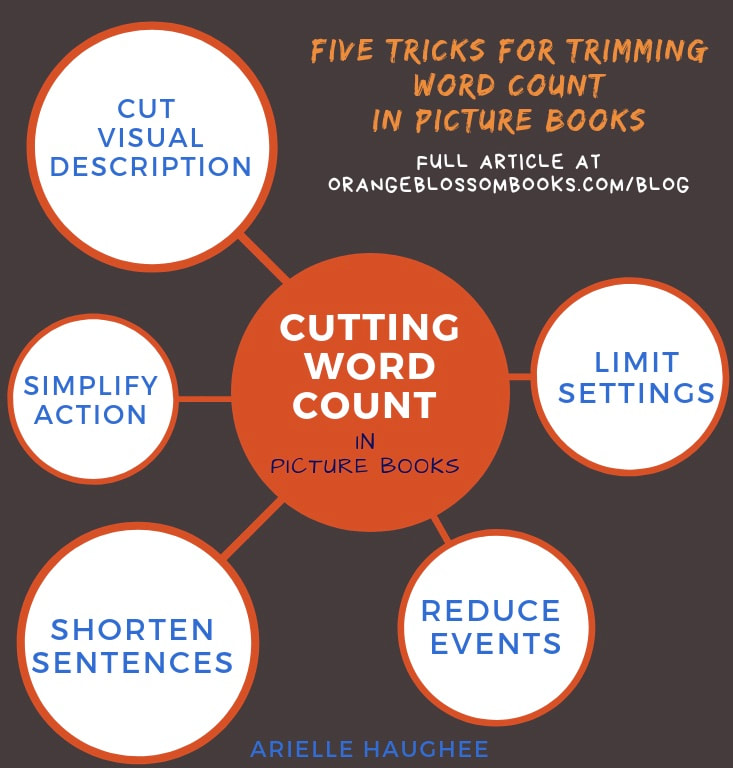|
A picture book needs to use concise yet enticing language that lends itself well to being read aloud. The challenge? Doing all that in less than a thousand words, in fact, as close to 500 words as possible. First drafts are often too long since all you are doing is capturing your ideas and putting them on the page. Then it is time to revise, trim the fat, slice and dice...whatever you like to call it. A picture book manuscript is already fairly short, so what exactly can you cut? Here are five tricks to trim down those words: Shorten Sentences This is the first place to start. Take a close look at your sentence structures. Do you have sentences with several clauses strung together? Long compound sentences? Search your manuscript for lengthy sentences and see where you can chop. Become a hound on the hunt for any extra words. Look for adverbs and adjectives and determine if they are truly necessary. The word “that” is often a filler word when not specifying an object. (If you are looking for more tips at the sentence level, see Tighten Up! Seven Tips for Decluttering Your Sentences, an article I wrote for the Florida Writers Association.) Cut Out Visual Description Visual description, such as describing the setting or what the character looks like, is usually left out of picture books. Most obviously because the pictures show the visuals and it would be superfluous. The second reason is that illustrators do not want to be told how things look. There needs to be room for creative interpretation. (More on this in another post.) So look through your story and see if there are any lines that tell what something looks like and ask yourself if they are really necessary or if the pictures will show it. Simplify Action A common mistake is to assume kids need tons of action in a picture book in order to keep their interest, making it more like a TV show. Characters are here then there then up then down then karate chop! Big action isn’t a bad thing, but too much action is. The first problem is that it’s hard for children to follow. Adults, too. Second, an illustrator doesn’t create an individual scene for every single little action in the book. (Think about transitions like opening doors and entering rooms.) So if you have too much action, an illustrator won’t be able to draw it all anyway. Limit your action to what is essential to your plot. Ask yourself what *must* the character do and limit the number of obstacles to what will fit within the word count. Which leads to the next tip… Reduce the Number of Events Oftentimes writers get excited about the idea behind a picture book and add in too many events. My very first picture book attempt involved a tough-guy Easter bunny and his peppy sidekick. While I was developing the story, I planned a kooky system for how they traveled around the world. The first few events in the book where all about glitches in the system before they got to where the story actually started. It was exciting and fun and I loved it. It was also totally unnecessary. My word count was a shocking 2,000 words. It broke my heart but those events had to be cut. A good trick to help focus your events is to write your logline: one sentence saying what your book is about. Events need to be directly related to the direction of the book. How many events should there be for a picture book? It depends on the structure of the book. I tend to use a simplified version of the three act structure, so three events or event groups. Examine the structure of your book and determine if there are any events that can be left out and the end result would be the same. That may be an indicator they can be cut. Limit Settings It’s not always necessary to show every setting in a book. A character may come home from school and have to walk through the foyer, then the living room, then the hallway before getting to her bedroom. Save yourself some words and jump straight to where she needs to be. Limiting settings also goes hand-in-hand with simplifying action. If you stick to only the necessary scenes that involve the obstacles and the character’s goal, then you will see which settings are integral and which can be cut. Once again, the structure of the book will determine the number of settings. Keep Working On It It takes me several months to work over a manuscript and get it where it’s ready to publish. I revise over and over and over, getting lots of feedback from other picture book authors. Keep coming back to your manuscript and asking yourself what is essential to your story. With time and effort, you’ll be able to cut out the excess and highlight what is truly important.
Happy writing!
10 Comments
8/13/2019 12:05:33 am
I used to read picture books all day, that was when I was still a kid. Well, I never really liked playing outside, to me, it is such a huge waste of time. I understand that not everyone is like me, which is why I do not judge others. If you ask me, reading picture books was the best thing that I child can do. Reading picture books allow children to learn and be more creative, at least that is what happened to me.
Reply
Arielle Haughee
8/17/2019 09:01:06 am
Picture books are wonderful tools to get kids to love books just like you did. I also enjoy books more than movies/tv where I can visualize the world in my mind. Thanks for taking the time to comment!
Reply
Arielle Haughee
12/2/2019 02:32:38 pm
It's around two pages double spaced, depending on how many words you put per line. Good question!
Reply
Loraine Phillips
1/5/2021 12:59:18 pm
This was such a helpful blog. I had way too much text and descriptions so I spent time taking it out and deleting pages. After I did this, I was second guessing my decision until I found you on the website and this post.
Reply
Arielle Haughee
1/6/2021 07:00:36 am
I am so glad you found this helpful, Loraine. Best of luck with your manuscript!!
Reply
Robin George
7/18/2021 09:06:20 pm
Dear Arielle,
Reply
Susan Nelson
8/26/2023 11:54:48 am
I need some help reducing the word count in my picture book.
Reply
Leave a Reply. |
AuthorArielle Haughee is the owner and founder of Orange Blossom Publishing. Categories
All
|


 RSS Feed
RSS Feed